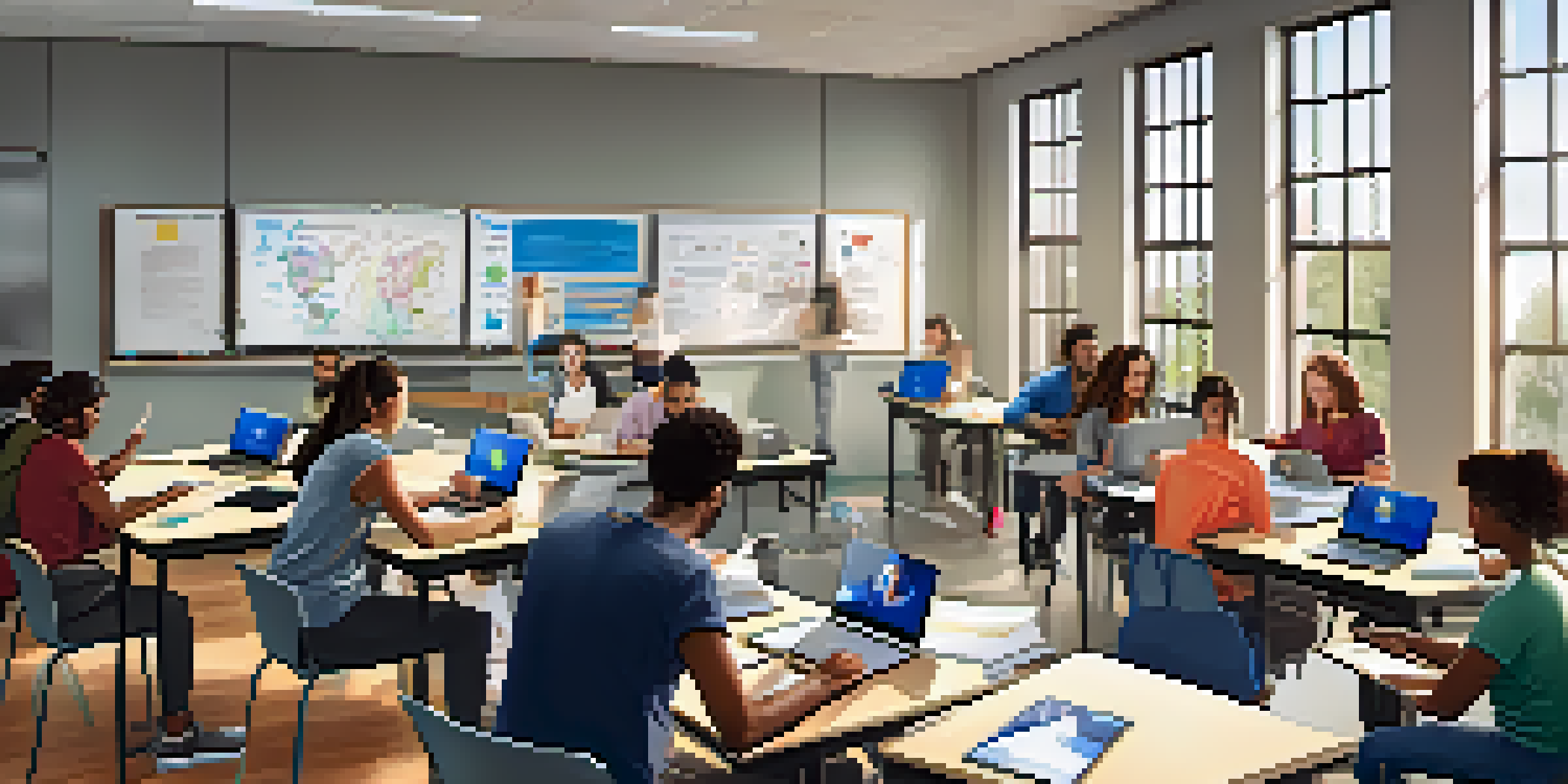Investigating Blended Learning's Role in Adult Literacy Programs

Understanding Blended Learning and Its Benefits
Blended learning combines traditional face-to-face instruction with online elements, creating a flexible learning environment. For adult learners, who often juggle multiple responsibilities, this approach can be a game-changer. It allows them to learn at their own pace while still benefiting from direct interaction with instructors and peers.
Blended learning is an approach that combines the best of both worlds—traditional face-to-face instruction with the flexibility of online learning.
One of the key benefits of blended learning is its accessibility. Adults can fit lessons into their busy schedules, whether during lunch breaks or late at night. This flexibility is crucial for those balancing jobs, family, and education.
Moreover, blended learning can cater to diverse learning styles. Some learners thrive with hands-on activities, while others prefer digital resources. This adaptability can lead to better engagement and improved literacy outcomes.
The Role of Technology in Adult Literacy
Technology plays a significant role in blended learning, offering various tools that enhance the learning experience. From interactive apps to online discussion forums, these resources can engage adult learners in new and exciting ways. For example, using gamified applications can make reading and writing practice feel less like a chore and more like a fun challenge.

Additionally, technology allows for personalized learning paths. Educators can track progress through online platforms, tailoring lessons to meet individual needs. This ensures that learners receive the support they require, whether they are beginners or more advanced.
Blended Learning Enhances Flexibility
This approach allows adult learners to balance education with their busy lives by combining in-person and online instruction.
Finally, the use of technology fosters digital literacy, which is increasingly important in today's job market. By integrating these skills into adult literacy programs, we prepare learners not just to read and write but to navigate the digital world confidently.
Challenges of Implementing Blended Learning
While blended learning offers many advantages, it also presents challenges that must be addressed for successful implementation. One significant hurdle is the digital divide; not all adult learners have equal access to technology or the internet. This disparity can create barriers to participation and must be considered when designing programs.
Technology is a tool. The real impact comes from how we use it to enhance learning experiences and outcomes.
Another challenge is the need for training for both educators and learners. Instructors must be comfortable with technology to guide their students effectively, while learners may require support in navigating online platforms. Without proper training, the potential of blended learning can be lost.
Lastly, the balance between online and in-person instruction must be carefully managed. Too much reliance on one method can lead to disengagement. Finding the right mix is essential to maintain motivation and ensure that all learners benefit from the program.
Engagement Strategies in Blended Learning
To maximize the benefits of blended learning, educators should employ various engagement strategies. Interactive content, such as quizzes and discussion prompts, can keep learners interested and motivated. Additionally, incorporating real-life scenarios related to adult learners' experiences makes lessons more relatable and practical.
Peer collaboration is another effective strategy. Creating opportunities for learners to work together on projects or discussions fosters a sense of community. This not only enhances learning but also builds valuable social connections, which can be particularly important for adult students.
Technology Personalizes Learning
Leveraging technology enables tailored learning experiences that meet individual needs and foster digital literacy.
Regular feedback is crucial in blended learning environments. Educators should provide timely, constructive feedback on assignments and participation. This helps learners understand their progress and areas for improvement, fostering a growth mindset.
Case Studies: Success Stories in Blended Learning
Several adult literacy programs have successfully integrated blended learning, showcasing its potential. For instance, a program in Chicago combined online lessons with weekly workshops, resulting in significant improvements in reading levels among participants. These case studies highlight how blending different learning modes can cater to diverse adult learners' needs.
Another notable example comes from a rural community in Texas, where technology was used to connect learners with experienced instructors from urban centers. This innovative approach not only improved literacy rates but also expanded participants' networks, opening doors to new opportunities.
These success stories serve as inspiration for other programs considering blended learning. By sharing effective strategies and outcomes, they can encourage more adult literacy initiatives to adopt similar models.
Future Trends in Blended Learning for Adults
As technology continues to evolve, the future of blended learning in adult literacy looks promising. Emerging tools like artificial intelligence (AI) and virtual reality (VR) have the potential to create even more immersive learning experiences. For example, AI can offer personalized learning recommendations based on individual progress, while VR can simulate real-world scenarios for practical application.
Additionally, the growing acceptance of online education among employers is likely to influence adult literacy programs. As more companies recognize the value of digital credentials and skills, learners may be more motivated to engage in blended learning to enhance their employability.
Addressing Challenges is Crucial
To successfully implement blended learning, it's essential to overcome barriers like the digital divide and ensure proper training for educators and learners.
Finally, increased collaboration among educational institutions, employers, and technology providers can lead to innovative solutions that expand access to adult literacy programs. By working together, stakeholders can address challenges and create a more equitable learning environment for all.
Conclusion: Embracing Blended Learning for Adult Literacy
In conclusion, blended learning has the potential to transform adult literacy programs by making education more accessible and engaging. By combining traditional methods with technology, we can cater to diverse learning styles and schedules, ultimately improving literacy outcomes. However, it's essential to address challenges such as the digital divide and ensure that both learners and educators receive adequate training.
As we look toward the future, embracing innovative technologies and strategies will be vital in enhancing the effectiveness of blended learning. Success stories from various programs demonstrate that this approach can lead to significant improvements in adult literacy rates.

Ultimately, by prioritizing blended learning, we can empower adults to enhance their literacy skills, opening doors to greater opportunities in both personal and professional spheres.